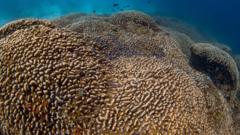The recently discovered coral, possibly over 300 years old and measuring 34 meters wide, was found by a National Geographic team in the Pacific Ocean. This finding underscores the need for conservation efforts as coral reefs face severe threats from climate change.
Discovery of the World's Largest Coral Offers Hope Amid Climate Crisis

Discovery of the World's Largest Coral Offers Hope Amid Climate Crisis
A monumental finding in the Solomon Islands has unveiled the largest coral ever recorded, highlighting the resilience of marine ecosystems against climate change.
In a groundbreaking discovery, scientists have identified the world's largest coral in the southwest Pacific Ocean, a find that may spark renewed hope for marine ecosystems in the face of climate change. This remarkable specimen—a collection of interconnected coral polyps—can potentially exceed 300 years in age and measures a staggering 34 meters in width, making it larger than even a blue whale.
The coral was found near the Solomon Islands by videographer Manu San Felix, who was part of a National Geographic expedition exploring remote oceanic regions. During a dive intended for a shipwreck search, he encountered the immense coral structure, likening it to an "underwater cathedral." He described the experience as emotional, recognizing the coral's endurance over centuries, stating, "I thought, 'Wow, this was here when Napoleon was alive.'"
Globally, coral reefs are under severe threat as climate change leads to rising ocean temperatures. Corals, which consist of thousands of tiny living organisms known as polyps, form communities that can create extensive reef structures, crucial for marine biodiversity. These reefs sustain the livelihoods of over one billion people by supporting industries such as tourism and fishing, as noted by the World Economic Forum.
Significantly, the newly discovered coral thrives in deeper waters, which may have insulated it from the harsher conditions faced by surface reefs. This discovery was shared during the UN climate talks COP29 in Baku, Azerbaijan, where climate minister for the Solomon Islands, Trevor Manemahaga, emphasized the need to protect this unique marine environment. He highlighted the nation's dependence on marine resources, warning of the perils posed by climate change, such as intensified cyclones and coastal erosion.
Developing nations like the Solomon Islands are seeking additional funding from wealthier countries to bolster their climate strategies. Manemahaga noted that increasing financial support would enable the creation of diverse job opportunities, thereby reducing reliance on industries like logging, which contributes to water pollution harmful to coral ecosystems.
Eric Brown, a coral scientist involved in the National Geographic research, acknowledged the newfound coral's health as encouraging. As he stated, "Witnessing this large healthy coral oasis in slightly deeper waters is a beacon of hope" amid deteriorating nearby reefs. The coral species, Pavona clavus, serves as a habitat for various marine life, including shrimp, crabs, and fish.
The age of this coral also positions it as a valuable record of historical ocean conditions, offering researchers a chance to study its growth patterns in relation to changing environmental factors. Nevertheless, the urgency of coral conservation remains high, as recent reports indicate that 44% of corals in warm waters face extinction threats—an alarming rise from previous assessments in 2008.





















